This was published 4 years ago
Brisbane's original Chinatown found under Albert Street
By Tony Moore
Evidence of a thriving working-class Chinese community with eateries, pubs, saddlery, leather shops, grocers and cheap accommodation from the 1870s and 1880s have been unearthed beneath Albert Street in Brisbane's CBD.
Archaeologist Kevin Rains said the site, which Brisbane historians call Frog's Hollow, was Brisbane's original Chinatown, 70-odd years before Chinatown in Fortitude Valley and more than a century before Brisbane's modern Chinatown at Sunnybank.
Frog's Hollow was the boggy, low-lying area that ran from the bottom of Albert Street near the Botanic Gardens towards Elizabeth Street and stretching two or three blocks either side of Albert Street.
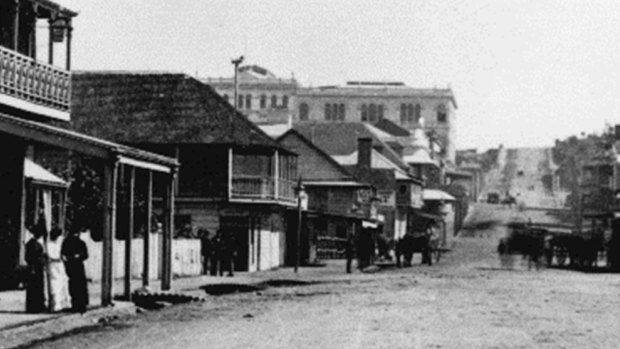
The 9 Holes section of Brisbane's Albert Street with Mary Street in the mid-background.Credit: State Library of Queensland
Dr Rains, who works for Niche Environment, said the "significant archaeological finds" were "absolutely invaluable" to learn about Brisbane's earliest days.
"Queensland was a later colony. There was a lot of diversity and development and a lot of 'get up and go'," he said.

Dr Kevin Rains from Niche Environment and Heritage with the Cross River Rail project.
"There was a lot of wealth even in those early days. People were already building up strong businesses."
About 200 artefacts - tobacco and opium pipes, leather goods, bottles, crockery, old books, skeletons of animals, walls and pipes and a perfume container - have all been unearthed.
Some small containers held pickles and soya sauce, Dr Rains said.
"It is equivalent to the Rocks area of Sydney or Little Lonsdale street in Melbourne," he said.
"It was a working-class area, but also highly multicultural, with people of British and European backgrounds but also Chinese, South Sea Islanders and people from other parts of Asia living there as well.
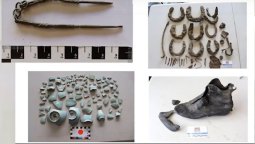
Chinese leather works found under Lower Albert Street during Cross River rail excavation team.
"It had food shops, opium dens, hotels, lots of boarding houses, and a mix of grocers, all sorts of things.
"We have found evidence of a saddlery - Robert Schute's Saddlery - and a leather shoemaker."
Large numbers of Chinese, who came to Queensland for the gold at Gympie, eventually returned to Brisbane.
"In Queensland the gold rushes began to peter out around the 1880s and there was legislation keeping them from prospecting and working on the gold fields, so a lot of them moved into Brisbane and began setting up business there," Dr Rains said.
One foundation wall unearthed by the excavation crew working on Albert Street comes from the Gympie Hotel, which later became Brannelly's Oriental Hotel in 1885.
"We found old walls on both sides of the [Albert] street," Dr Rains said.
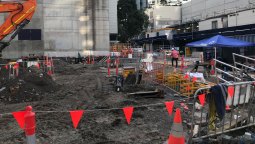
One of two excavation sites on Brisbane’s Albert Street where artifacts from Brisbane earliest days have been found.Credit: Tony Moore
"We found some of the foundation of the original Gympie Hotel on the left hand side and we've also found wall and floors from the old saddlery and the Nine Holes shops on the other side.
"Nine Holes was was row of shops on the north side of Albert Street where the [Cross River Rail] station is being built today and Brannelly's Colonial Hotel was on the other side, the southern side."
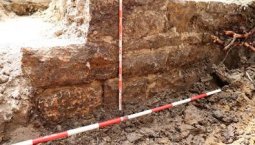
An old stone wall uncovered as the Cross River Rail's Albert Street station is built.Credit: Tony Moore
The Frog's Hollow excavation work was completed in January 2020.
"A bit after that we did all the analysis of all the actual artefacts and I'm in the process now of writing up the report for the state government," Dr Rains said.
Dr Rains said archaeologists very much hoped to find parts of early Brisbane as the excavation work for Cross River Rail.
"But we were not sure. We knew some of the buildings that were built along Albert Street in the 1920s, now demolished, had fairly shallow foundations, so there was a lot of potential for a lot of earlier material to be underneath it," he said.
"The big surprise was Brannelly's Oriental Hotel because they built a 1970s building - which they demolished in the 1980s - over the top of it.
"It was built on the same spot as the Gympie Hotel - corner of Albert and Mary streets - and it [the Gympie Hotel] got redeveloped in 1885 as Branelly's Oriental Hotel.
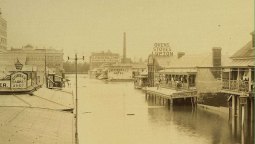
Looking down Albert Street's Frog Hollow during the 1893 Floods towards the Oriental Hotel on Mary Street.Credit: State Library of Queensland
"It was built from stone and brick. But in the 1980s it got demolished and a 1980s-style corporate tower got built there.
"Its a bit of a shame. The photos show it had lovely iron lace work that there was during those times. It was like the Bellevue Hotel, the same period.
"So while we didn't think we would find a lot because the big corporate towers were built, we did find a lot of the foundations, which was very good."